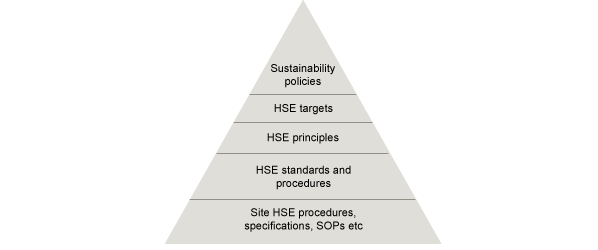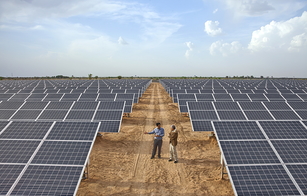To support the implementation of the Group Policies, an HSE management system has been developed and implemented to improve our performance related to health, safety and environment.
The REC HSE management system follows a structured approach to manage HSE risks, and consists of the Group policies, HSE targets & KPI’s, HSE principles, Group HSE standards and local HSE procedures. (See picture of pyramid below)
The HSE principles establish the REC Group’s expectations and implementation methods for managing HSE. To ensure compliance, an assessment has been developed where the practical implementation methods are explained in order to secure and improve HSE standards and share best practices across the Group. The assessment tool rates the implementation methods on a scale of Low – Average – Good – Best Practice – World Class, according to the use of the REC Business System rules & principles. All manufacturing plants perform annual self-assessments according to this tool, and the results are used for prioritizing improvement actions and programs.

The HSE Principles are:
1. Leadership and Commitment
Management and staff understand their HSE accountabilities and are responsible for leading and engaging in meeting policies, management principles, standards, procedures and objectives.
2. Policy and Strategic Objectives
HSE policies are established, HSE objectives are set and an HSE management system is implemented to achieve the requirements of the policies.
3. Roles, Responsibilities and Competence
HSE is a line responsibility. Organization, roles and HSE responsibilities are clearly defined and documented. Personnel are competent to conduct their assigned roles and activities.
4. Risk Management
Hazards are identified and associated risks assessed. Risks are managed to a level that is tolerable and as low as reasonably practicable (ALARP principle). Changes in design, operations, procedures, site standards, facilities, equipment or personnel are evaluated and managed to ensure that HSE and process safety risks arising from these changes remain at an acceptable level.
5. Product Stewardship
Product Stewardship is ensured in the whole lifecycle from R&D, design, sourcing, manufacturing, distribution, installation, maintenance, decommissioning through disposal and recycling. All products are in compliance with relevant prevailing legislative regulations.
6. Supply Chain Management
Contracting of services and the purchase, hire, or lease of equipment and materials are carried out in a manner to ensure that HSE requirements are met.
7. Design and Construction
Facilities, utilities and equipment and modifications of these, are designed, procured, constructed, and commissioned to manage HSE risks through their life cycle.
8. Operations and Maintenance
All facilities, utilities and equipment are operated, maintained, inspected, and tested using systems and procedures that manage HSE risks.
9. Incident Management
Incidents are reported, investigated, mitigated and communicated. Incidents are investigated for root causes and analyzed for trending patterns. Effective corrective and preventive actions are taken and lessons shared to reduce future injuries and losses.
10. Emergency Management
Procedures and resources are in place to effectively prepare and respond to emergency situations to protect people, the environment, the REC reputation and property. Threats and risks of emergency are identified in the whole value chain and measures are taken to manage them.
11. Occupational Health and Safety Management
Employees are fit to perform their required duties. Appropriate controls are in place to provide protection from the health and safety hazards associated with the whole company’s activities.
12. Environmental and Climate Management
REC is committed to maximize the positive contribution from renewable and climate-friendly solar energy at affordable prices globally. This includes maximizing the energy efficiency of its products, minimizing negative environmental impacts and carbon footprint as well as preventing pollution from all business activities and products. REC operates in compliance with national legislation and applicable external requirement related to the environmental aspects of its activities.
13. Documentation and Legal requirements
Applicable laws, regulations, permits, codes, standards, practices, and other requirements are identified and complied with, and documentation is managed through formally controlled processes. Records are maintained and readily available.
14. Performance Monitoring, Assessment, Review and Improvement
HSE performance and systems are monitored, audited, and reviewed to identify trends, measure progress, assess compliance , drive continuous improvement, and provide assurance that governing processes are working effectively.






